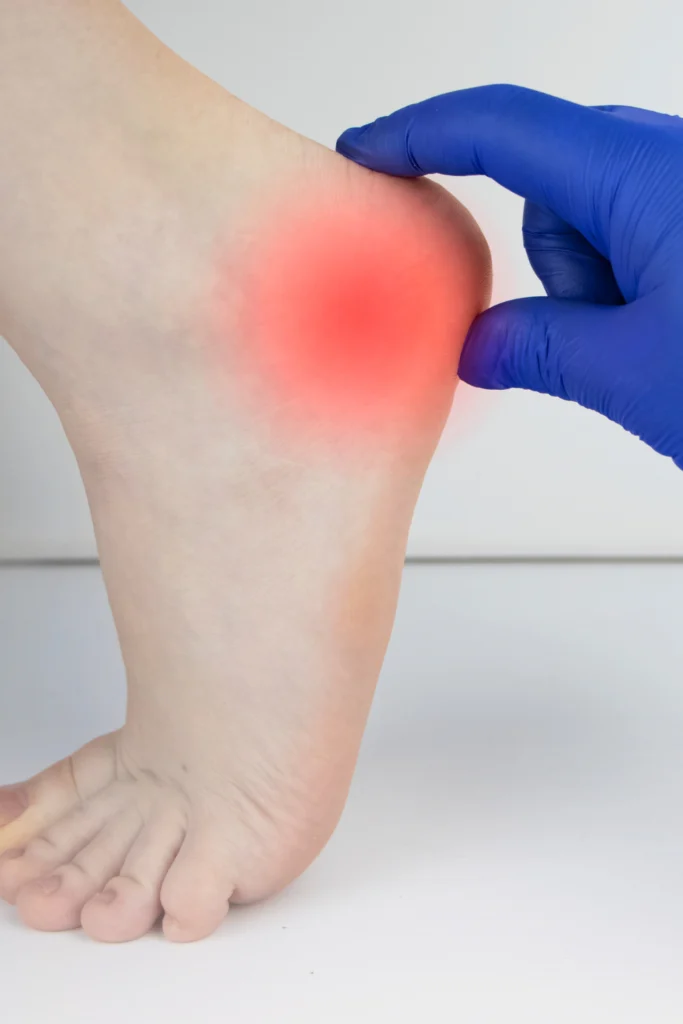Foot and heel pain are unfortunately common injuries in the running community.
If you run regularly, you have probably experienced heel pain at one time or another.
Ignoring or pushing through the pain can lead to further strain or injury.
So it’s important you recognise and identify the underlying cause of the pain before continuing running.
But what exactly causes heel pain after running? And how do you prevent heel pain from occuring in the first place?
In this guide we’ll explore:
- What is heel pain after running?
- What causes heel pain after running?
- Who is at risk of developing heel pain after running?
- How to treat heel pain after running
- How to prevent heel pain after running
- 3 plantar fasciitis stretches and exercises
Ready?
Let’s go!

What is heel pain after running?
Heel pain after running is characterised by a sharp pain in the back of the heel or around the arch of the foot.
Any runner can experience it, but there are certain factors that predispose you to heel pain after running – which we will go into later.
Most heel pain is associated with a condition called plantar fasciitis, but there are also other causes of heel pain which we will look at below.
Related: Hip pain after running: 8 causes + how to fix it
What causes heel pain after running?
There are many causes linked to heel pain after running – from structural damage to imbalances in the foot.
Here are the causes of heel pain after running:
- Plantar fasciitis
- Achilles tendonitis
- Heel spur syndrome
- Bursitis of the heel
Plantar fasciitis
Plantar fasciitis is one of the most common causes of heel pain after running.
It involves the inflammation of the thick band of tissue (called the plantar fascia) that runs along the bottom of your foot, connecting your heel bone to your toes.
The pain is normally at the bottom of your foot, around your heel and arch. You may also feel pain directly under the ball of your heel.
Pain with plantar fasciitis is most commonly felt first thing in the morning or immediately after resting.
It can also feel better during exercise, but return when resting after exercise.
Achilles tendonitis
Achilles tendonitis is a common overuse injury of the Achilles tendon, which is a band of tissue that connects the calf muscles at the back of your lower leg to your heel bone.
The pain normally starts as a dull ache at the back of the leg or above the heel after running.
You may also feel tenderness or stiffness, particularly in the morning.
Runners are more susceptible to Achilles tendonitis when they take sudden jumps in their training (such as increased intensity or duration).
Heel spur syndrome
A heel spur is a bony protrusion on the underside of the heel bone. A spur can extend by as much as half an inch.
Heel spurs are commonly associated with plantar fasciitis as they can cause heel pain.
You are more at risk of heel spurs if you run on hard surfaces, you’re overweight, or wear poorly fitting or worn out running shoes.
Having flat feet or high arches are also risk factors for heel spurs.
Bursitis of the heel
Bursitis is a condition that causes the swelling of the bursa at the back of the heel.
A bursa is a fluid-filled sac that acts as a cushion and lubricant between tendons and muscles sliding over the bone.
There are bursas around most large joints in the body.
With bursitis, you will feel pain at the back of the heel, especially when walking, running or standing on your tiptoes.
You may also have red, warm skin at the back of the heel. As such, it may be painful to touch.
Runners who take sudden jumps in their mileage or do a lot of high intensity exercise are more at risk of developing bursitis.
Related: Overtraining syndrome: 11 signs of overtraining
Other causes of heel pain after running
Here are other causes of heel pain after running:
- Imbalances in the foot or leg
- Improper running form
- Improper gait pattern
Related: What is proper running form?

Who is at risk of developing heel pain after running?
You are at risk of developing heel pain after running if you:
- Run on hard surfaces
- Exercise with tight calves
- Take sudden leaps in your training (either by increasing the distance or intensity of your runs)
- Run in worn out running shoes
- Wear running shoes with little support or cushioning
- Run using a heel footstrike
- Have flat feet or high arches
- Are very overweight
Related: IT band syndrome: How to fix it + 7 training mistakes to avoid
How to treat heel pain after running
Here are the steps that you should take to treat the pain:
#1 Rest
As soon as you start to feel pain in your heel when running, stop and try to identify the cause of the pain.
If you ignore or push through the pain, it could lead to further strain or injury.
#2 Ice
Applying ice to your heel will help to relieve the pain.
Ice will help to reduce the pain by decreasing inflammation in the affected areas.
Apply an ice pack for 20 minutes at a time, every 2 to 3 hours.
#3 Take pain medication
Pain medication such as ibuprofen and aspirin will help to reduce the pain and inflammation.
#4 Take a break from running
Take a break from running until the pain gets better and the inflammation disappears.
You should resume running only once the symptoms have cleared up.
#5 Do some gentle stretches
In the absence of any running, do some gentle foot and calf stretches as these will help to speed up the recovery process.
At the end of this guide you will find some sample stretches and exercises.
Be mindful that some stretches may irritate the injury and inflame tissues, to be sure to check which stretches are best for you before starting your stretching routine.
#6 See a sports podiatrist
A sports podiatrist (foot specialist) will be able to carry out a detailed examination of your foot in order to identify the underlying cause of your heel pain.
They will take into account your previous and current running history, check the range of motion in your lower leg, and conduct a gait assessment if required.
They may also request an x-ray or ultrasound of the affected area.
A podiatrist can also recommend things like insoles and the right shoes to wear.
#7 See a physiotherapist
If your heel pain does not get better, you may be referred to a physiotherapist.
A physiotherapist can show you exercises to help ease your symptoms.
#8 Try shock wave therapy
If your heel pain persists, you may want to speak with a healthcare professional about having shock wave therapy.
Shock wave therapy is a noninvasive procedure which involves the use of a probe that sends bursts of high energy sound waves into the painful area into the tissues.
This then sends signals to the brain to repair the injured or inflamed tissues, which has the potential to relieve pain almost instantly.
According to a 2020 study, a single dose of shock wave therapy was effective for plantar fasciitis treatment and brought about improvements in pain, function and quality of life.
Related: Knee pain after running

How to prevent heel pain after running
Now you know all about the causes of heel pain after running and how to treat it, here are ways to prevent heel pain after running.
#1 Warm up before each run
Taking a few moments to do a warm up before your run will go a long way to help reduce the risk of heel pain after running, and other common running injuries.
Aim to do a gentle jog, followed by some dynamic foot and ankle stretches.
#2 Improve your foot strike
A heel foot strike is a common stride pattern for runners. This is when your heel hits the ground first
It is thought that a heel foot strike contributes to heel pain, so aim to run using a midfoot strike pattern instead.
A midfoot strike pattern is when the middle of your foot hits the ground first, causing less impact forces to travel up through your foot into your leg and hips.
Check out my guide on running foot strike for more information and advice.
#3 Wear the right running shoes
A good pair of running shoes will provide the comfort and support that your foot needs when running, therefore reducing the risk of common running injuries.
The right running shoes will also provide your feet with the proper structure they need.
Check out my guide on finding the right running shoes for more information.
A podiatrist will also be able to recommend running shoes if you regularly experience heel pain after running.
#4 Maintain a healthy weight
If you’re overweight, you will be placing more pressure on your feet and legs, especially your knees, ankles and heels when you run.
Aim to maintain a healthy weight so you are lighter on your feet when exercising, which will help to reduce heel pain.
#5 Stretch
Stretching is beneficial to help minimise the risk of injury and to promote flexibility – which we runners often lack!
Aim to do a daily stretching routine – not just as part of a warm up or cool down.
At the end of this guide you will find some recommended calf and foot stretches.
#6 Avoid sudden jumps in your training
Avoid taking sudden leaps in your training (such as increasing the distance or intensity of your runs) as this can result in injury and training overload.
Use the 10% principle – that is increase the distance or intensity of your runs by 10% each time.
Related: Knee brace for running: When to wear one + where to buy

3 plantar fasciitis stretches and exercises
These stretches and exercise will help to stretch the plantar fascia which is the thick band of tissue that runs from your heel to your toes.
A physiotherapist will also be able to recommend stretches based on your symptoms.
#1 Plantar fascia stretch
For this stretch you will need a chair and either a frozen water bottle or foam roller.
- While seated, roll your foot back and forth over the frozen water bottle or foam roller.
- Do this for 1 minute and then switch to the other foot.
#2 Big toe stretch
For this stretch you will need a chair.
- While seated, cross one leg over the other then grab your big toe and pull it gently towards you and hold for 15 to 30 seconds.
- Do this 3 times, then reverse and do the same with the other foot.
#3 Folded towel stretch
Again, for this stretch you will need a chair and a towel.
- While seated, fold a towel lengthwise to make a strap.
- Place the towel strap under the arches of both feet, then grab the ends of the towel with both hands.
- Gently pull the tops of your feet toward you and hold for 15 to 30 seconds.
- Repeat 3 times.
- 5 things I wish I’d known before returning to running - March 3, 2024
- Running 20 minutes a day: Benefits + how to start - January 27, 2024
- How to run your first 2 hour half marathon - January 16, 2024
